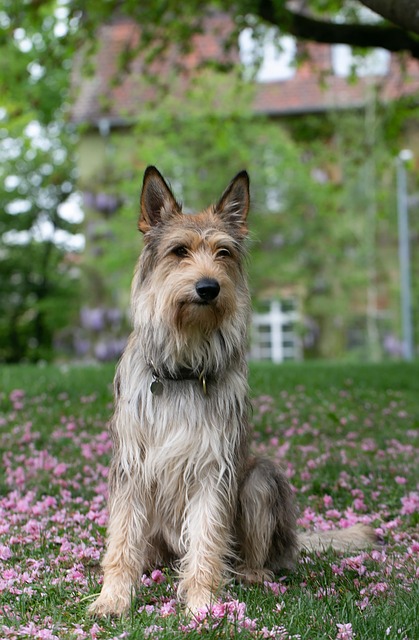


The Berger Picard, also known as the Picardy Shepherd, is a rare and distinctive herding breed from France. Known for its playful and intelligent nature, the Berger Picard is a versatile dog, historically used for herding sheep and working alongside farmers. With its unique coat, erect ears, and confident demeanor, this breed has a rugged charm. Despite its working dog origins, the Berger Picard is also an affectionate companion and loyal family dog, forming strong bonds with its owners. It thrives in an active household and makes an excellent partner for those who enjoy outdoor activities.
The Berger Picard’s history dates back to ancient times in northern France, where it was bred for herding livestock, particularly sheep. Its exact origins are not well-documented, but it is believed to be one of the oldest French herding breeds, closely related to other herding dogs such as the Beauceron and the Briard. The breed’s name, "Picard," comes from the Picardy region in northern France, where the breed was primarily used. The Berger Picard played a vital role in French farming life, helping to guide and protect livestock. Despite its historical importance, the breed nearly disappeared after World War II, but it has been slowly revived in recent decades, particularly in Europe and North America. The Berger Picard was officially recognized by the American Kennel Club (AKC) in 2015.
The Berger Picard is a medium-sized dog with a distinctive and rough-coated appearance. Adult males typically stand between 23 to 25 inches tall at the shoulder, while females are slightly smaller at 21 to 23 inches. The breed’s weight ranges from 50 to 70 pounds, with a lean but muscular build that reflects its herding background. One of the most striking features of the Berger Picard is its dense, wiry coat, which is weather-resistant and comes in various shades of fawn, gray, and brindle. The coat’s texture helps protect the dog from the elements while working outdoors. The Berger Picard also has a characteristic face with erect ears, a long nose, and expressive, dark eyes that convey intelligence and alertness. Its tail is long, bushy, and often carried low, though it may be raised during play or excitement.
The Berger Picard is known for its intelligent, energetic, and playful nature. It is an alert and attentive dog, with a strong desire to work and please its owner. Though it has a natural herding instinct, the Berger Picard is also affectionate and loyal, forming deep bonds with its family members. This breed is generally good with children and other pets, especially when properly socialized from an early age. However, the Berger Picard is a strong-willed dog and can sometimes be independent, requiring an experienced and consistent owner to ensure good behavior. It is a highly social breed and does not do well being left alone for long periods of time, as it can become anxious or bored. With its playful attitude and natural curiosity, the Berger Picard is a fun-loving companion, often enjoying games and interactive activities with its family.
The Berger Picard is an active and high-energy breed that requires plenty of physical and mental exercise. As a working herding dog, it thrives in environments where it can run, play, and engage in stimulating activities. Regular walks, runs, and play sessions are essential to keep this breed healthy and happy. It also benefits from engaging in activities such as obedience training, agility, and interactive games that challenge its sharp mind. Due to its herding background, the Berger Picard enjoys activities that allow it to "work" in a controlled manner, and it excels in dog sports like herding trials or agility courses. Without enough exercise, this breed can become bored, which may lead to undesirable behaviors. Providing consistent mental stimulation and physical activity is essential for a well-behaved and content Berger Picard.
The Berger Picard is an intelligent and eager-to-please dog, but it can also be independent and strong-willed, making consistent training important. Positive reinforcement methods work best for this breed, as they respond well to praise, treats, and rewards. Early socialization is crucial for helping the Berger Picard grow into a well-rounded and confident dog, especially since it may be reserved around strangers and unfamiliar situations. It is important to expose the Berger Picard to a variety of people, animals, and environments during its puppyhood to ensure it becomes well-adjusted. Although the breed can sometimes be stubborn, its high intelligence and desire to please make it very trainable, especially with an experienced owner who can provide clear and consistent guidance.
The Berger Picard is generally a healthy breed, but like all dogs, it can be prone to certain health conditions. Some common health concerns include hip dysplasia, progressive retinal atrophy (PRA), and epilepsy. Regular veterinary check-ups are essential to monitor for any health issues. The breed’s wiry coat requires regular grooming to prevent mats and tangles. Weekly brushing is typically sufficient, but more frequent grooming may be necessary if the coat becomes particularly tangled. Berger Picards are also prone to ear infections, so regular ear cleaning is important to maintain good hygiene. The breed’s exercise needs are considerable, so providing plenty of opportunities for activity is vital to prevent obesity and maintain overall health. A balanced, high-quality diet is also important for their well-being.
The Berger Picard has an average lifespan of 12 to 14 years. With proper care, including regular exercise, a healthy diet, and routine veterinary visits, many Berger Picards live long, healthy lives. Regular check-ups can help detect and treat any health conditions early, improving their chances for a longer, happier life. Like all breeds, genetics play a role in their lifespan, but with proper care, this breed can enjoy a long and fulfilling life as a loyal family companion.
© copyright Dog Compendium 2024 - 2025